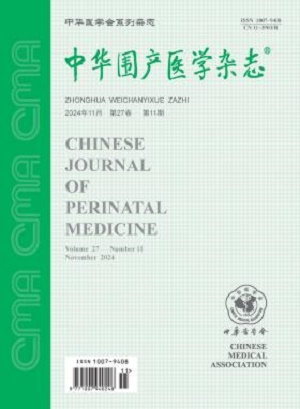超重/肥胖孕妇皮下脂肪组织维生素D受体和血清维生素D水平与妊娠期糖尿病的关系
Q4 Medicine
引用次数: 0
摘要
目的探讨超重/肥胖孕妇与正常体重孕妇皮下脂肪组织中维生素D受体(VDR)表达及血清维生素D水平的差异及其与妊娠期糖尿病(GDM)的关系。方法选取2015年1月至2017年4月南京医科大学附属常州市妇幼保健院择期剖宫产的单胎足月妊娠孕妇。其中,GDM女性70例,其中体重正常(NW-GDM组)35例,超重/肥胖(low -GDM组)35例。同时选取70例经剖宫产的糖耐量正常的孕妇作为对照组,其中体重正常的35例(nw对照组)和肥胖/超重的35例(low对照组)。术前采集空腹血,测定维生素D、血脂、空腹血糖、空腹胰岛素、脂联素等不同生物标志物水平,计算稳态模型评估-胰岛素抵抗(HOMA-IR)。术中取两组腹壁皮下脂肪组织,免疫组化检测VDR蛋白的表达和分布。同时采用实时荧光定量聚合酶链反应定量分析VDR mRNA转录水平。统计学分析采用单因素方差分析、LSD、Kruskal-Wallis检验、Mann-Whitney U检验、卡方检验和logistic回归分析。结果(1)低体重对照组和低体重gdm组孕前和分娩前体重指数(BMI)均高于nw -对照组和NW-GDM组[孕前BMI:(29.2±2.9)、(29.4±3.8)vs(21.1±2.3)、(21.9±2.0)kg/m2, F=87.766;交货前BMI:(35.2±3.4),(35.1±4.3)和(27.9±2.8)和(28.8±3.3)kg / m2, F = 44.827;所有P < 0.001)。低gdm组新生儿出生体重和糖尿病家族史比例高于NW组和OW组[(3 893±498)vs(3 501±402)和(3 625±332)g, F=4.751;22.9%(8/35)和5.7%(2/35)和5.7%(2/35),χ2 = 7.869;所有P < 0.05)。(2)低剂量对照组空腹胰岛素水平和HOMA-IR高于nw对照组,脂联素和维生素D浓度低于nw对照组[13.3(12.3-14.5)vs 12.0(10.4-13.3) mmol/L, 2.7(2.4-3.0) vs 2.2(2.0-2.7),(61.8±20.4)vs(74.9±29.3)ng/ml,(21.6±7.2)vs(25.9±7.3)ng/ml;低- gdm组与NW-GDM组的结果相似[15.3(12.3-19.5)vs 12.0(10.1-15.8) mmol/L, 3.4(2.6-4.1) vs 2.6(2.1-3.2),(50.3±22.3)vs(62.1±23.2)ng/ml,(17.1±6.7)vs(20.6±7.9)ng/ml,均P<0.05]。与nw -对照组相比,NW-GDM组空腹血糖升高,高密度脂蛋白-胆固醇(HDL-C)、脂联素和维生素D水平降低[4.6(4.3-5.1)vs 4.3(4.0-4.5) mmol/L, 1.7(1.6-1.9) vs 2.1(1.6~2.4) mmol/L,(62.1±23.2)vs(74.9±29.3)ng/ml,(20.6±7.9)vs(25.9±7.3)ng/ml;所有P < 0.05)。与低水平对照组相比,低水平gdm组空腹血糖、空腹胰岛素和HOMA-IR较高,HDL-C、脂联素和维生素D水平较低[4.7(4.4-5.4)vs 4.5(4.2-4.7) mmol/L, 15.3(12.3-19.5) vs 13.3(12.3-14.5) mmol/L, 3.4(2.6-4.1) vs 2.7(2.4-3.0), 1.6(1.4-1.8) vs 1.9(1.7-2.2) mmol/L,(50.3±22.3)vs(61.8±20.4)ng/ml,(17.1±6.7)vs(21.6±7.2)ng/ml;所有P < 0.05)。(3) 4组妊娠晚期总体维生素D缺乏率为78.6%(110/140),其中nw -对照组、低剂量对照组、NW-GDM组和低剂量gdm组维生素D缺乏率分别为62.8%(22/35)、82.8%(29/35)、77.1%(27/35)和91.4% (32/35)(χ2=8.994, P=0.029),低剂量gdm组维生素D缺乏率高于nw -对照组(χ2=8.102, P=0.004)。(4) VDR在所有样本的脂肪组织核中均有表达,四组间蛋白表达量有统计学差异。两个GDM亚组的VDR mRNA表达均高于两个对照亚组,两个超重/肥胖亚组的VDR mRNA表达也高于相应的正常体重亚组。(5)血清维生素D水平与空腹血糖、孕前BMI呈负相关,与脂联素呈正相关(P<0.05)。GDM的发生与糖尿病家族史、VDR mRNA、总胆固醇、HDL-C、HOMA-IR有关。结论GDM和超重/肥胖患者血清维生素D水平降低,皮下脂肪组织VDR升高。这两个因素与GDM密切相关。关键词:糖尿病;妊娠期;肥胖;超重;脂肪组织;骨化三醇受体;骨化三醇本文章由计算机程序翻译,如有差异,请以英文原文为准。
Vitamin D receptor in subcutaneous adipose tissue and serum vitamin D levels relate to gestational diabetes mellitus in overweight/obese pregnant women
Objective
To investigate the differences in the expression of vitamin D receptor (VDR) and serum vitamin D levels in subcutaneous adipose tissue between overweight/obese and normal-weight gravidas, and the relationship between these two indicators and gestational diabetes mellitus (GDM).
Methods
Women with full-term singleton pregnancies who underwent elective cesarean section in Changzhou Maternal and Child Health Care Hospital Affiliated to Nanjing Medical University from January 2015 to April 2017 were enrolled. Among them, there were 70 cases GDM women, including 35 normal-weight (NW-GDM group) and 35 overweight/obese women (OW-GDM group). During the same period, another 70 pregnant women with normal glucose tolerance who underwent scheduled cesarean delivery were selected as the control group, including 35 normal weight women (NW-control group) and 35 obese/overweight women (OW-control group). Fasting blood samples were collected before operation to determine the levels of different biomarkers, including vitamin D, lipid, fasting blood glucose, fasting insulin and adiponectin, and to calculate the homeostasis model assessment-insulin resistance (HOMA-IR). Two subcutaneous adipose tissue samples of the abdominal wall were taken during the operation to detect the expression and distribution of VDR protein with immunohistochemistry. Meanwhile, VDR mRNA transcription level was quantitatively analyzed using real-time fluorescence quantitative polymerase chain reaction. One-way analysis of variance, LSD, Kruskal-Wallis test, Mann-Whitney U test, Chi-square test and logistic regression analysis were used for statistical analysis.
Results
(1) The body mass index (BMI) of the OW-control group and the OW-GDM group before pregnancy and delivery were all higher than that of the NW-control group and the NW-GDM group [BMI before pregnancy: (29.2±2.9), (29.4±3.8) vs (21.1±2.3) and (21.9±2.0) kg/m2, F=87.766; BMI before delivery: (35.2±3.4), (35.1±4.3) vs (27.9±2.8) and (28.8±3.3) kg/m2, F=44.827; all P<0.001]. Newborn birth weight and the proportion of diabetic family history in the OW-GDM group were higher comparing to the NW- and OW- control group [(3 893±498) vs (3 501±402) and (3 625±332) g, F=4.751; 22.9%(8/35) vs 5.7%(2/35) and 5.7%(2/35), χ2=7.869; all P<0.05]. (2) In the OW-control group, the fasting insulin level and HOMA-IR were higher and the adiponectin and vitamin D concentration were lower than those in the NW-control group [13.3(12.3-14.5) vs 12.0(10.4-13.3) mmol/L, 2.7(2.4-3.0) vs 2.2(2.0-2.7), (61.8±20.4) vs (74.9±29.3) ng/ml, (21.6±7.2) vs (25.9±7.3) ng/ml; all P<0.05], and similar results were found between the OW-GDM group and the NW-GDM group [15.3(12.3-19.5) vs 12.0(10.1-15.8) mmol/L, 3.4(2.6-4.1) vs 2.6(2.1-3.2), (50.3±22.3) vs (62.1±23.2) ng/ml, (17.1±6.7) vs (20.6±7.9) ng/ml, all P<0.05]. Compared with the NW-control group, the NW-GDM group had higher fasting glucose and lower high density lipoprotein-cholesterol (HDL-C), adiponectin and vitamin D levels [4.6(4.3-5.1) vs 4.3(4.0-4.5) mmol/L, 1.7(1.6-1.9) vs 2.1(1.6~2.4) mmol/L, (62.1±23.2) vs (74.9±29.3) ng/ml, (20.6±7.9) vs (25.9±7.3) ng/ml; all P<0.05]. Compared with the OW-control group, fasting glucose, fasting insulin and HOMA-IR were higher and HDL-C, adiponectin and vitamin D levels were lower in the OW-GDM group [4.7(4.4-5.4) vs 4.5(4.2-4.7) mmol/L, 15.3(12.3-19.5) vs 13.3(12.3-14.5) mmol/L, 3.4(2.6-4.1) vs 2.7(2.4-3.0), 1.6(1.4-1.8) vs 1.9(1.7-2.2) mmol/L, (50.3±22.3) vs (61.8±20.4) ng/ml, (17.1±6.7) vs (21.6±7.2) ng/ml; all P<0.05]. (3)The overall vitamin D deficiency rate during the third trimester of the four groups was 78.6% (110/140), and the figure was 62.8% (22/35), 82.8% (29/35), 77.1% (27/35) and 91.4% (32/35) in the NW-control group, OW-control group, NW-GDM group and OW-GDM group (χ2=8.994, P=0.029), indicating a higher rate in the OW-GDM group than that in the NW-control group (χ2=8.102, P=0.004). (4) VDR was expressed in the nucleus of adipose tissue in all samples and statistic difference in protein expression was found among the four groups. VDR mRNA expression was higher in both GDM subgroups than that in the two control subgroups, and also higher in the two overweight/obese subgroups than in the corresponding normal-weight subgroups. (5)Serum vitamin D level was negatively correlated with fasting blood glucose and pre-pregnancy BMI, and positively correlated with adiponectin (P<0.05). The incidence of GDM was related to family history of diabetes, VDR mRNA, total cholesterol, HDL-C and HOMA-IR.
Conclusions
GDM and overweight/obese patients had decreased serum vitamin D level and increased VDR in subcutaneous adipose tissue. These two factors are closely related to GDM.
Key words:
Diabetes, gestational; Obesity; Overweight; Adipose tissue; Receptors, calcitriol; Calcitriol
求助全文
通过发布文献求助,成功后即可免费获取论文全文。
去求助
来源期刊

中华围产医学杂志
Medicine-Obstetrics and Gynecology
CiteScore
0.70
自引率
0.00%
发文量
4446
期刊介绍:
Chinese Journal of Perinatal Medicine was founded in May 1998. It is one of the journals of the Chinese Medical Association, which is supervised by the China Association for Science and Technology, sponsored by the Chinese Medical Association, and hosted by Peking University First Hospital. Perinatal medicine is a new discipline jointly studied by obstetrics and neonatology. The purpose of this journal is to "prenatal and postnatal care, improve the quality of the newborn population, and ensure the safety and health of mothers and infants". It reflects the new theories, new technologies, and new progress in perinatal medicine in related disciplines such as basic, clinical and preventive medicine, genetics, and sociology. It aims to provide a window and platform for academic exchanges, information transmission, and understanding of the development trends of domestic and foreign perinatal medicine for the majority of perinatal medicine workers in my country.
 求助内容:
求助内容: 应助结果提醒方式:
应助结果提醒方式:


